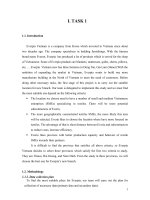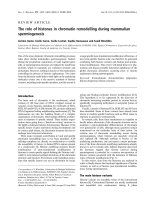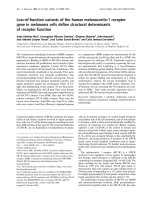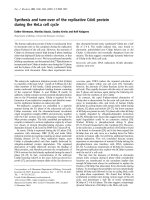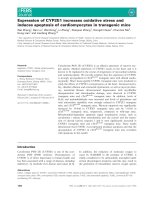LOSS OF SIMPL INCREASES TNFα SENSITIVITY DURING HEMATOPOIESIS
Bạn đang xem bản rút gọn của tài liệu. Xem và tải ngay bản đầy đủ của tài liệu tại đây (1.88 MB, 158 trang )
LOSS OF SIMPL INCREASES TNFα SENSITIVITY DURING
HEMATOPOIESIS
Eric Ashley Benson
Submitted to the faculty of the University Graduate School
in partial fulfillment of the requirements
for the degree
Doctor of Philosophy
in the Department of Biochemistry and Molecular Biology
Indiana University
October 2008
ii
Accepted by the Faculty of Indiana University, in partial
fulfillment of the requirements for the degree of Doctor of Philosophy.
_____________________________________
Maureen Harrington, Ph.D., Chair
_____________________________________
Mark Goebl, Ph.D.
Doctoral Committee
_____________________________________
Wade Clapp, M.D.
October 15, 2007
_____________________________________
David Skalnik, Ph.D.
iii
DEDICATION
This thesis is dedicated to my wife, Heather Benson, for her endless love, support
and encouragement throughout our marriage and particularly during my thesis process;
and to my parents Errol and Lessa Benson for constant love and a solid foundation upon
which I continue to build to this day.
iv
ACKNOWLEDGEMENTS
I would like to thank my mentor, Dr. Maureen Harrington, for providing guidance
towards the completion of my thesis and for developing me into a complete scientist. Dr.
Harrington spent endless hours guiding me through the inner workings of running a lab,
and many more critically thinking about scientific questions. From the moment I met Dr.
Harrington, her passion for research was evident, and that passion was instilled in me. I
would like to thank Harrington Lab members, Erin Breese, Yong Luo, and Angelia
Lockett for also providing guidance and mentorship.
I would like to thank members of my committee, Dr. Harrington, Dr. Mark Goebl,
Dr.Wade Clapp, and Dr. David Skalnik for their guidance and encouragement throughout
this training process. I especially would like to thank Dr. Wade Clapp, the Clapp Lab,
and Dr. Feng-Chun Yang for their wonderful guidance, instruction, and dedication to this
process, along with the reagents needed for the accomplishment of the bone marrow
studies.
I would like to acknowledge other individuals and institutions at Indiana
University that contributed support to my research including Dr. Rueben Kapur, Dr. Hal
Broxmeyer, the Indiana University Cancer Center Flow Cytometry Resource Facility -
especially Susan Rice and Lizz Scaletta - and the Goebl Lab.
I would like to thank my family for constant support and understanding
throughout this difficult pursuit, even as I became recluse as research intensified.
v
Most importantly, I would like to thank my wife and inspiration, Heather Lynette
Benson, who was my strength when I was empty. She provided unconditional love,
constant hope and objective guidance. I cannot imagine arriving at this point without her.
vi
ABSTRACT
Eric Ashley Benson
LOSS OF SIMPL INCREASES TNFα SENSITIVITY DURING HEMATOPOIESIS
The innate and adaptive immune responses are critical for host survival. The
TNFα/NF-κB signaling pathway is a major regulator of the immune response. The
TNFα/NF-κB signaling pathway has also been proposed to play a role in the regulation of
hematopoiesis. In the TNFα signaling pathway, full induction of NF-κB (specifically the
p65 subunit) dependent transcription is regulated by a co-activator SIMPL. The
biological significance of SIMPL in TNFα dependent responses is poorly understood. To
study SIMPL in vitro and in vivo in mammalian cells, a knockdown system utilizing
shRNA (short hairpin RNA) was used. Analysis of hematopoietic progenitor cells
infected with a retrovirus encoding the SIMPL shRNA was used to study the role of
SIMPL in hematopoiesis. The ability of progenitor cells lacking SIMPL to grow and
differentiate was not compromised. In contrast in the progenitors cells lacking SIMPL,
TNFα mediated inhibition of colony formation was significantly enhanced. These
growth inhibitory effects of SIMPL were not due to an increase in apoptosis.
vii
The enhanced inhibitory affects were specific for TNFα and not found in other common
hematopoietic inhibitors (TGF-β1 and IFNγ). Results of this work reveal that SIMPL is a
component of the hematopoiesis that is required for TNFα dependent effects upon
myeloid progenitors.
Maureen Harrington, Ph.D., Chair
viii
TABLE OF CONTENTS
I. Background and significance 1
A. The Immune response 1
B. TNFα signaling 2
C. NF-κB, a transcription factor 3
D. NF-κB activation 4
E. TNF-RI activation of NF-κB 5
F. SIMPL 7
G. Role of TNF-RI dysregulation, a role for TNF-RII 8
H. Basics of hematopoiesis 9
I. Evidence for TNF-RI/NF-κB involvement in differentiated
hematopoietic cell types 13
J. NF-κB (p65/p50) involved with terminal precursors of
differentiated cell types 15
K. Understanding TNFα in immature progenitor and hematopoietic
stem cells 18
1. Overview 18
2. TNFα inhibits proliferation of precursor hematopoietic cells 20
3. TNFα promotes differentiation of hematopoietic precursors 24
a. Overview 24
ix
b. First scenario: Understanding differentiation by pre-treated
HSCs and HPCs with TNFα before placement into
proliferation/differentiation Assay 25
c. Second Scenario: Understanding differentiation by
concurrent addition of TNFα with myelopoietic
colony formation 27
4. Summary 29
L. Receptor specific role of TNF-RI in hematopoietic
immature precursors 29
1. Role of TNF-RI on Proliferation 30
2. Role of TNF-RI on Differentiation 31
a. TNF-RI specific influences on the First Scenario 31
b. TNF-RI influences on the Second Scenario 33
3. Summary 33
M. Exploration of TNFα through examination of diseases 33
1. AML- Role of dysregulated TNFα/NF-κB system 34
2. Myelodysplastic Syndrome 36
N. Hypothesis 39
II. Methods 41
A. Plasmid constructs 41
B. Antibodies 41
C. Cytokines, Growth Factors, Chemokines 42
D. Cell culture and transfection 43
x
E. Mice 44
F. Bone marrow cells and LDMNC separation 44
G. Retroviral packaging of plasmid and collection 45
H. Retroviral transductions 47
I. Fluorescence activated cell sorter and analyzers 48
J. Staining for c-kit
+
cells containing shRNA 49
K. Apoptosis Assay 50
L. Growth inhibition assay 51
M. Progenitor (differentiation and proliferation) colony assay for c-kit
+
,
whole bone marrow and spleen 51
N. Whole bone marrow cellularity assay using transplanted animals 53
O. Real-time PCR 53
P. Cell Lysates 54
Q. Protein Assay 54
R. Immunopreciptation 55
S. Western Blot analysis 56
T. Lineage cell depletion by magnetic cell sorting 56
U. Transplant experiment 57
V. Competitive repopulation 58
III. Results 59
A. Develop a suitable model system to characterize the
physiological role of SIMPL 59
1. Zebra fish (Preliminary) SIMPL knockdown results 59
xi
2. SIMPL knockdown system created to model effects of
SIMPL on hematopoiesis 59
a. ShRNA generation and construction 59
b. SIMPL shRNA knocks down mRNA and protein levels 62
B. Loss of SIMPL Sensitizes CFU-GM cells to TNFα 69
1. Mouse TNFα in PWMSCM inhibits CFU-GM colonies
with loss of SIMPL 69
2. Human TNFα in PWMSCM inhibits CFU-GM colony
formation with loss of SIMPL. PWMSCM effects on
TNF-RI dependent progenitor proliferation 73
3. To explore the effects of TNFα on subsets, CFU-GM colonies were
subcategorized 76
4. Loss of TNF-RI specific inhibition of CFU-GM with diminished
SIMPL in the absence of PWMSCM 77
C. Isolation of the cause of TNF-RI inhibition of CFU-BM
in PWSCM sensitization in PWMSCM by removal of PWMSCM
and addition of various growth factors 80
1. Mouse TNFα without PWMSCM causes inhibition of
CFU-GM colony formation with loss of SIMPL 80
2. Neither of the two other important inhibitors (IFNγ or TGF-β1)
of hematopoiesis cause inhibition of CFU-GM colony formation
with knock down SIMPL levels 84
a. Interferon gamma (IFNγ) does not decrease CFU-GM
xii
with SIMPL shRNA 84
b. Tumor growth factor-Beta 1 (TGF-β1) not decrease
CFU-GM with SIMPL 87
3. p65 controlled erythropoietin does not cause further
inhibition of TNF-RI with PWMSCM 88
4. Lack of progenitor growth not caused by increasing
levels of GM-CSF, therefore GM-CSF activation of p65
is not SIMPL dependent 93
D. Loss of SIMPL allows normal GM-CFU colony formation
in the absence of TNFα 93
E. TNF-RI inhibition of CFU-GM with diminished SIMPL not
caused by apoptosis from analysis of various apoptosis conditions 95
1. No increased apoptosis of progenitors with knock down SIMPL
in presence of cytokine that allows for differentiation 96
a. Suspension cells 96
b. Total cells (adherent and suspension cells) 96
2. No increase in apoptosis of LDMNCs with diminished
SIMPL supplied with cytokines that allow only
proliferation/expansion 100
3. No increased apoptosis of LDMNCs with loss of SIMPL
in SFM used to induce apoptosis 103
F. C57BL-6 mice transplanted with HSCs with knock down
xiii
levels of SIMPL have TNFα induced sensitivity 105
1. Significant decreases in the growth of bone marrow
progenitors in SIMPL knockdown group versus scrambled
control in a TNFα concentration dependent manner 105
2. No change in the number of colonies formed without
the addition of mTNFα in the SIMPL compared scrambled
shRNA groups 106
3. Number of cells in the bone marrow, and type of cells from
mice with SIMPL shRNA were similar to control 110
4. SIMPL knockdown underwent a slight, but significantly
decreased amount of early apoptosis 110
5. One outlier in the SIMPL shRNA group had expanded HSC
and immature precursor populations with decreased
apoptosis (data not shown) 113
6. GFP equally shutoff in SIMPL and scramble groups 113
IV. Discussion 115
A. Myelopoietic, CFU-GM, colonies with loss of SIMPL behave
similarly to CFU-GM exposed to high dose TNFα 115
B. Loss of SIMPL allows for normal CFU-GM colony formation
in the absence of TNFα highlighting the advantage of
pathway specific therapy 116
C. Similar to high dose TNFα, decrease CFU-GM formation from
xiv
loss of SIMPL is not caused by apoptosis 118
D. CFU-GM colony inhibition from the loss of SIMPL requires
both TNF-RI and TNF-RII 119
E. Neither TGF-B1 nor IFN-g sensitizes CFU-GM colonies
with diminished SIMPL levels 121
F. EPO and G-CSF do not allow further inhibition of colonies
with diminished SIMPL levels while GM-CSF highlights
SIMPL’s specificity to TNFα 121
V. Conclusion 123
VI. Future Directions 124
VII. References 126
VIII. Curriculum Vitae
xv
LIST OF TABLES
Table 1. Increasing levels of MDS severity and relation to TNF-RI
and TNF-RII levels 38
Table 2. Proliferation/Differentiation Assay Base Contents 52
Table 3. No change in bone marrow cellularity comparing mice
transplanted with scramble or SIMPL shRNA 111
xvi
LIST OF FIGURES
Figure 1. TNFα sigaling to NF-kB and SIMPL co-activation 6
Figure 2. Dose dependent effects of TNFα 10
Figure 3. Mouse Hematopoiesis 12
Figure 4. Mouse Hematopoiesis 16
Figure 5. Mouse Hematopoiesis 17
Figure 6. GFP shRNA retroviral plasmid vector 61
Figure 7. SIMPL 18 shRNA knocks down SIMPL levels 63
Figure 8. Optimized level of SIMPL 18 shRNA knocks down SIMPL levels 64
Figure 9. Transduced SIMPL 18 shRNA knocks down endogenous
SIMPL levels in BAF3 65
Figure 10. SIMPL 18 and SIMPL 664 shRNA knocks down endogenous
SIMPL levels 66
Figure 11. Decreased SIMPL expression MEFs leads to specific decrease
endogenous SIMPL protein in MEFs transduced with SIMPL shRNA 67
Figure 12. Decreased SIMPL expression in lin-sca- c-kit
+
cells containing
SIMPL shRNA 68
Figure 13. Loss of SIMPL significantly inhibited total colony growth
at 1, 5, and 10 ng/mL mTNFα 71
xvii
Figure 14. SIMPL and scramble shRNA c-kit
+
colonies growth were
significantly inhibited by mTNFα. Compared 0 ng/mL to
10 ng/mL mTNFa to determine if any inhibition occurred
within each group 72
Figure 15. Loss of SIMPL significantly inhibited CFU-GM
at 1, 5, and 10 ng/mL hTNFα 74
Figure 16. SIMPL shRNA c-kit
+
colonies growth were significantly
inhibited by hTNFα in PWM with Epo, but Scramble was not 75
Figure 17. Loss of SIMPL has no effect upon hTNFα dependent
inhibition of CFU-GM formation 78
Figure 18. SIMPL LPP and Total colony formation were significantly
inhibited by hTNFα along with Scramble shRNA c-kit
+
total
colony growth 79
Figure 19. SIMPL shRNA c-kit
+
LPP and total colonies showed
significant inhibition of colony growth compared to scrambled
shRNA control at 10 ng/mL mTNFα without PWM 81
Figure 20. SIMPL shRNA c-kit
+
LPP and total colonies showed
significant inhibition of colony growth compared to scrambled
shRNA control at 10 ng/mL mTNFα without PWM 82
Figure 21. SIMPL shRNA LPP and Total colony growth was
significantly inhibited at maximum dose mTNFα (10 ng/mL),
while scramble shRNA c-kit
+
colony growth was not 83
xviii
Figure 22. Loss of SIMPL has no effect upon mIFNγ dependent inhibition
of CFU-GM formation 85
Figure 23. SIMPL and scramble shRNA c-kit
+
colonies growth
were significantly inhibited by mIFNγ 86
Figure 24. Loss of SIMPL has no effect upon hTGF-β1 dependent
inhibition of CFU-GM formation 88
Figure 25. For SIMPL, HPP colony growth was significantly inhibited
by hTGF-β1, however scramble shRNA c-kit
+
LPP colony
growth was significantly inhibited 89
Figure 26. Loss of SIMPL significantly inhibited total colony formation
at 1, 5, and 10 ng/mL hTNFα 91
Figure 27. SIMPL shRNA c-kit
+
colonies growth were significantly
inhibited by hTNFα in PWM and Epo, but scrambled was not 92
Figure 28. Loss of SIMPL has no effect upon untreated CFU-GM formation
without PWMSCM 94
Figure 29. No apparent difference in apoptosis on c-kit
+
SIMPL shRNA
containing cells compared to c-kit
+
scramble containing cells 97
Figure 30. No apparent difference in apoptosis on c-kit
+
SIMPL shRNA
containing cells compared to c-kit
+
scramble containing cells 99
Figure 31. No apparent difference in apoptosis on c-kit
+
SIMPL shRNA
containing cells compared to c-kit
+
scramble containing cells
in pre-stimulation conditions 101
xix
Figure 32. No apparent difference in apoptosis on c-kit
+
SIMPL shRNA
containing cells compared to c-kit
+
scramble containing cells
in serum free media 104
Figure 33. SIMPL shRNA whole bone marrow colonies showed significant
difference from scrambled shRNA control at 5 and 10 ng/mL
mTNFα 106
Figure 34. SIMPL shRNA whole bone marrow colonies showed significant
difference from scrambled shRNA control at LPP 5 and
10 ng/mL mTNFα 107
Figure 35. SIMPL LPP, HPP and Total whole bone marrow had significant
inhibition by mTNFα while scramble whole bone marrow only
LPP was significantly inhibited 108
Figure 36. SIMPL and scramble whole nucleated bone marrow had no
significant change in the total number of cells 109
Figure 37. No apparent difference in apoptosis on SIMPL shRNA containing
cells compared to scramble containing cells 112
Figure 38. SIMPL and scramble whole nucleated bone marrow had
no significant change in % GFP positive cells 114
xx
ABBREVIATIONS
7-AAD 7-Amino-actinomycin D
AML Acute myeloid leukemia
AP1 Activator protein 1
BAF3 Pro B-cell line
BFU-E Blast forming unit-erythrocyte
BIR Baculoviral IAP Repeat
BrdU 5-bromo-2-deoxyuridine
CAPS 10 mM 3-cyclohexylamino-1-propanesulphic acid
CD3 Cluster of differentiation 3
CFU-GEMM Colony forming unit-granulocyte erythrocyte macrophage
megakaryocyte
CFU-S Colony forming unit-spleen
cIAP Cellular inhibitor of apoptosis
c-kit Stem cell factor receptor
Con A Concanavalin A
c-Rel V-rel reticuloendotheliosis viral oncogene homolog with additional
C-terminal residues
CSF Colony stimulating factors
DMEM Dulbecco’s Modified Eagle’s Medium
DMSO Dimethyl sulfoxide
DNA Deoxyribonucleic acid
xxi
Epo Erythropoietin
FACS Fluorescence activated cell sorter/scan
FBS Fetal bovine serum
G-CSF Granulocyte-colony stimulating factor
GM-CSF Granulocyte-macrophage colony stimulating factor
HEK 293 Human embryonic kidney epithelial cells
HPC Hematopoietic progenitor cell
HPP High proliferative potential colony
HSC Hematopoietic stem cell
IFNγ Interferon gamma
IgG Immunoglobulin G
IgM Immunoglobulin M
IKK IκB kinase
IKKα IκB kinase alpha
IKKβ IκB kinase beta
IKKγ NEMO
IL-2 Interleukin-2
IL-3 Interleukin-3
IL-8 Interleukin-8
IMDM Iscove's Modified Dulbecco's Medium
IRAK-1 Interleukin-1 receptor associated kinase 1
IκB Inhibitor of κB
IκBα Inhibitor of κB alpha
xxii
IκBβ Inhibitor of κB beta
IκBγ Inhibitor of κB gamma
KFT3 C-kit, flt3 ligand, thrombopoietin, interleukin-3
LDMNC Low density mononuclear cell
Lin Lineage markers
LN2 Liquid nitrogen
LPP Low proliferative potential colony
LPS Lipopolysaccharide
LTBMC Long term bone marrow culture
LTC Long term culture
LTC-CFC Long term culture colony forming cell
LTC-IC Long term culture initiating cell assays
LTα Lymphotoxin-α
M-CSF Macrophage colony-stimulating factor
mdr1 Multiple drug resistance gene 1
MDS Myelodysplastic syndrome
MEKK3 Mitogen-activated protein kinase kinase kinase 3
MPP Multipotential Progenitors
mSCF Mouse stem cell factor
mTNFα Mouse TNFα
NEMO Nuclear factor kappaB essential modulator
NES Nuclear export sequence
NF-κB Nuclear Factor-κB
xxiii
NLS Nuclear localization signal
NOD/SCID Non-obese diabetic-severe combined immunodeficient
p100 NF-κB2
p105 NF-κB1
p50 NF-κB1
p52 NF-κB2
p65 Rel A
PBS Phosphate buffered saline
PI Propidium iodide
PMA Phorbolmysteric acid
PWMSCM Poke weed mitogen spleen conditioned media
RA Refractory Anemia
RAEB RA with excess blasts
RAEB-T RAEB in transformation
RelA V-rel reticuloendotheliosis viral oncogene homolog A
RelB V-rel reticuloendotheliosis viral oncogene homolog B
RHD Rel homology domain
rhIL-3 Recombinent human IL-3
RIP1 Receptor interacting protein 1
RNA Ribonucleic acid
Rpm Revolutions per minute
RT Room temperature
Sca Stem cell antigen
xxiv
ShRNA Short hairpin RNA
SIMPL signaling molecule that associates with mPLK
SRBC sheep red blood cells
TACE TNF alpha converting enzyme
TAD Transactivation domain
TGF-β1 Tumor growth factor-Beta
TNFα Tumor necrosis factor alpha
TNF-RI Type I TNF receptor
TNF-RII Type II TNF receptor
Tpo Thrombopoietin
TRADD TNF RI-associated death domain
TRAF2 TNF receptor-associated factor-2
1
I. Background and significance
Hematopoiesis is the process of normal replication and maturation of all blood
cell varieties in a host. The innate immune response is critical for normal host defense,
with the TNFα/NF-κB signaling pathway playing a major role. The TNFα/NF-κB
pathway also plays a less well understood role in the control of hematopoiesis. Full
transcriptional induction of NF-κB controlled genes, specifically hetero- or homodimers
of NF-κB that contain p65, in the TNFα pathway requires the transcriptional co-activator
SIMPL. Insight into the function of SIMPL in TNFα signaling events have been gained
using immortalized cell lines; however the role of SIMPL in a more physiological setting
has not been studied. The goal of my thesis project was to test the hypothesis that SIMPL
plays an integral role in the control of steady-state hematopoiesis.
A. The Immune response
Mammals and multicellular organisms have the ability to react to pathogens. For
mammals, this reaction requires an immune system, which can be divided into the innate
and the acquired immune responses. The acquired immune response has specificity, and
the ability to remember pathogens and to discriminate between self and non-self. The
acquired immune response includes B- and T-lymphocytes. In contrast, the innate
immune response is a non-specific response against pathogens including microbes or
macromolecules. It does not have the ability to remember a pathogen. The innate
immune response consists of physical barriers like the skin and mucous membranes, tears,
granular and phagocytic cells and circulating factors like antibodies (IgM) and
complement [6]. For example, during an innate immune response activated basophils and
